|
My name is Dave Gentry, and I've been asked to write a few words
about my latest boat, which is my take on J. Henry Rushton's "Igo"
Canadian style canoe.
 |
Dave and his IGO canoe. |
Henry Rushton owned a small boat building company back in the
late 1800's, and his boats are still revered today for their craftsmanship
and beauty. His company offered a variety of different boat styles,
including Adirondack Guide Boats, pulling boats, sailing craft
and many styles of canoes. Notable among these designs are his
Sairy Gamp, Indian Girl, Wee Lassie, Arkansaw Traveller and the
Vesper sailing canoe.
Rushton's IGO canoe was one of his "Canadian" canoe
designs. Others in that category were the aforementioned Arkansaw
Traveller, and his UGO. These three designs have remarkably similar
shapes above the waterline, but, underneath, the IGO is the least
extreme of them, having very little deadrise and - presumably
- being more stable than the other two (the Arkansaw Traveller
being reputedly the least stable, but fastest).
 |
Low tech pre-bending the gunwales. |
In a roundabout fashion, my desire to build another canoe coincided
with a good friend's need for a wedding present for her brother.
The newlyweds are mid sized folks, looking simply to mess about.
Though my friend wanted one of my Chuckanut 15 tandems for them,
I am rarely interested in building a certain design more than
once . . . so, I just shook my head "no" and told her
to trust me!
The IGO was my choice for several reasons, including historical
curiosity, appropriate capacity, looks and also because I had
built a Rushton in the past - a Wee Lassie solo canoe.
 |
Rushton Wee Lassie |
I picked the IGO over the UGO, and the Arkansaw Traveller, solely
because of the hull shape. I chose skin-on-frame because that's
the medium I am most adept at, and comfortable with. In any case,
there was no way would I ever be able to replicate the detailed
craftsmanship of Rushton's builders!
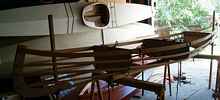 |
The frame, showing the 3 building forms, with
stems attached and ready for ribs. My Yost baidarka hangs
in the background. |
Building
Not having any plans, or anything other than the most basic
measurements to go by, step one was developing a set of offsets
for my building forms. Using as many drawings and old photographs
as I could find - and there weren't many - I used dividers and
an architect's scale to come up with some working drawings for
a multi-chine SOF conversion, as well as offsets for the stems
and the forms I would use.
Step two called for wood prep. I ripped the chines, wales and
keel from Western Red Cedar, and my rib stock from White Ash.
The rib stock was set to soaking, in water, until I needed them.
The gunwales were thoroughly soaked, as well, then supported at
each end, with buckets of water hanging from their centers. Left
this way at least overnight, the gunwales develop a permanent
bow, which helps retain the shape of the sheer. Straight gunwales
would always be fighting to hog the boat.
The inwales, floorboards and trim were to be from Redwood, and
I utilized 1/2 inch marine ply for the stems, and doubled 4mm
ply for the decks.
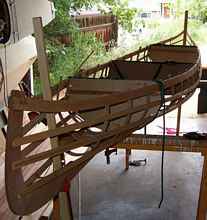
The frame with the ribs bent in & |

ready for fastening. |
My method for building this canoe, as with my earlier Wee Lassie,
differs from other SOF construction methods. In both cases, I
wanted to create a more or less exact shape, without "winging
it" and hoping for the best. So, I built these boats upright,
on a strongback, using three building forms - with the stringers
placed first and the ribs later bent in to shape. The building
forms consisted of a center form, and two others, identical to
each other, and placed equidistant from the center form. Since
the IGO is a symmetrical design, both halves of the hull are the
same.
The next step was to mount the forms to the strongback - merely
a straight two by six - and temporarily attach the stringers,
with webbing tie downs holding them in place. Then I fit the stems,
using stainless steel screws and thickened epoxy. This is the
point where it starts to look like a boat!
 |
The "IGO and Ruth" pic - Ruth is my
SOF rowing wherry, which we rowed alongside the IGO for pictures
and comparisons. |
The ribs, thoroughly soaked for a couple of days, were then
carefully bent in place, no steaming necessary. Some of the more
extreme bends required judicious use of a heat gun to fine tune
the fit, and a few ribs broke from grain run out, or - more usually
- from my lack of patience. It's always good to have extra rib
stock on hand, especially when I'm doing the bending!
I often lash kayak frames together, and did the same for my Wee
Lassie, but with the IGO I wanted a different look - and less
tedium! Instead, I fastened the ribs to the stringers with silicon
bronze ring shank nails. Unfortunately, this was still pretty
tedious, but worked well. The occasional dab of thickened epoxy
was also added where I felt there was some strain, or the fit
wasn't perfect. Hard to imagine that last bit, I know(!), but
it's true.
 |
 |
 |
 |
Once the ribs were in place, I added the decks (in a particular
style that Rushton offered), removed the building forms, fit the
inwales, installed the floorboards, took care of what sanding
and trimming needed to be done - too much, as always! - and painted
the entire frame with teak oil.
The skin, a very heavy gauge transparent vinyl, was stretched
tight and fastened along the upper, outside edge of the gunwales,
and to the stems, with many stainless steel staples. The staples
along the sheer were then covered by a redwood rubrail, mounted
with brass screws. The stems were covered with another layer of
vinyl, glued with HH-66 vinyl cement, making for a stronger and
totally waterproof seam.
Some temporary seats were whipped up, and we were off to the lake!
Paddling
I chose to build her 15 feet in length, a good length for two
medium sized paddlers, but not too much to solo. She came in at
about 36lbs - also not too much for a solo canoeist.
Rushton's Canadian Canoes came in a variety of lengths, but they
were consistently only 30 inches wide at 14-16 feet long. This
is much narrower than the average canoe being manufactured today,
so there was some concern on my part about how stable this boat
would be!
A day at the lake put those fears to rest completely, though.
Whew!
We launched the boat at scenic Gross reservoir, high in the mountains
above our homes in Boulder, Colorado. Gross is a far cry from
the typical prairie pond of the Front Range, with zero powerboats
or jet skis, and with mountains dropping straight down to the
shore. Definitely my favorite place to paddle in Colorado.
 |
The paddling pictures were all taken on Gross
Reservoir, near Boulder, Colorado. The paddlers are myself
(Dave Gentry) and Catherine and Shayna. Shayna is the blonde. |
Both of my test pilots, Catherine and Shayna, were novice boaters,
and excited to get up into the high country on a hot summer day.
They're quick learners, too, thankfully, and got to repeatedly
answer the slews of questions that every person on shore had.
I think it was a relief for them to start paddling!
Even though both ladies had never been in a canoe before, they
had zero issues with stability. I find that I am not a good judge
of this, as my reference, these days, is 18" wide kayaks.
It's nice to have unbiased opinions and obvious results! I did
paddle the boat myself, as well, both solo and double, and I agreed
with them that the boat was reassuringly stable, with nary a nerve
wracking moment. Paddling solo, I was able to stand up in her
without issue, though the water was pretty darn calm, at that
point!
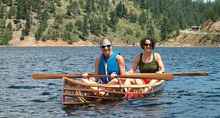 |
 |
 |
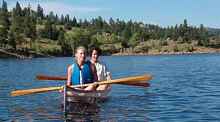 |
When we somehow got caught in the entirely foreseeable summer
storm, the ladies' only concern was getting back to the ramp as
fast as possible - not that they were going to capsize in the
big gusts and (small) chop. The sun came back out just as we were
starting to load up the car, of course, so we all headed back
out for another couple of hours. Nice.
You'll likely note the Greenland style kayak paddles, which were
the only ones I had lying around. I'm sure she paddles just fine
with traditional canoe paddles, as well. Also, it's clear from
the pictures that the rear thwart (seat) needs to be moved further
forward a bit. The seats are low, but comfortable.
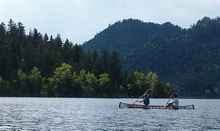 |
 |
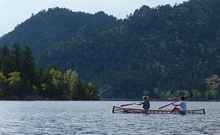 |
 |
Conclusion
Rushton's IGO, at least in this incarnation, is fast, has good
stability, works great with either one or two paddlers, and elicits
non-stop interest and comments from everyone who sees her. I heartily
recommend the design, and hope to see some more built, in any
medium. She's definitely not a whitewater or an expedition sized
craft, but just perfect for messing about on protected waters.
My version also has zero added floatation, so a bit of care is
in order, as well as the bit of care needed for preserving the
skin. The skin is very tough, indeed (I did a chin-up on a 4"
wide strip of it), but susceptible to sharp objects, of course
- personally, I'd try to avoid dragging her across razor blades
or barnacles! A puncture wouldn't spread, however, and would hopefully
not be disastrous.
All in all, she turned out to be a great looking, unique and distinctive
boat that also happens to handle superbly! Her new home will be
in the Boston area, so keep an eye out!
Thanks for reading - and feel free to check out some of my other
boats here.
Dave Gentry
Boulder, Colorado
https://www.gentrycustomboats.com/
Questions or comments?
Traveller1719@yahoo.com
References:
"Rushton
and His Times in American Canoeing" by Atwood
Manley.
"Rushton's
Rowboats and Canoes: The 1903 Catalog in Perspective"
by William Crowley
"Building
Classic Small Craft" by John Gardner
"Building
Skin-On-Frame Boats" by Robert Morris
"Baidarka:
The Kayak" by George Dyson
Tom Yost's www.Yostwerks.com
QajaqUSA.org
The Adirondack Museum https://www.adkmuseum.org/
*****

|





